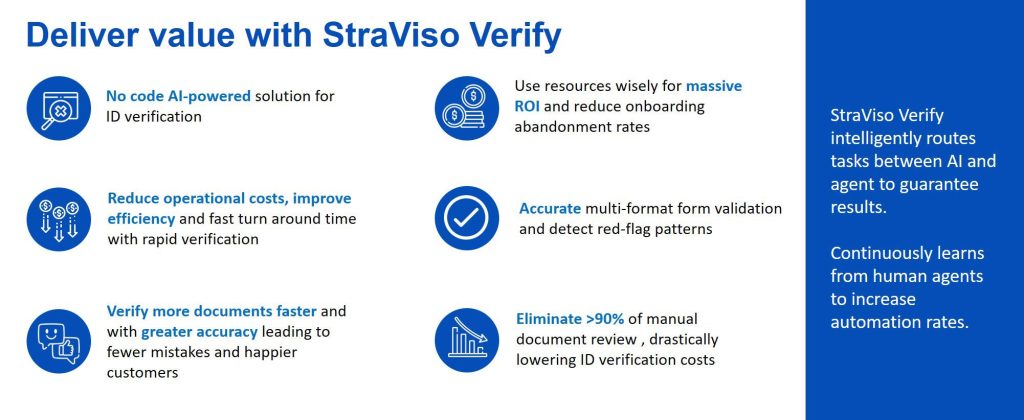Hyperautomation is crucial in B2B transactions for improving identity verification processes to confirm the authenticity of business entities and their representatives. This enhancement is essential for preventing fraud, ensuring compliance with regulations, and fostering trust during digital exchanges. Once slow and error-prone, identity verification is now revolutionized by AI-driven hyper-automation, enhancing speed, accuracy, and compliance with KYC and KYB regulations.
AI-driven hyper-automation is more than merely a technological improvement; it is a strategic imperative for businesses aiming to thrive in a digital-centric marketplace. Let’s explore how it is reshaping industry norms and significantly advancing operational efficiency, regulatory compliance, and security.
The Role of AI in Identity Verification
As digital interactions increase, traditional identity verification methods are struggling to keep pace, affecting security and efficiency.
- Fraud: Fraud sophistication is growing, with techniques like deepfake and advanced hacking overwhelming older systems. This calls for more advanced detection and mitigation solutions.
- Manual Errors: Manual verification processes are error-prone and tedious, leading to significant financial losses and damaged business credibility, especially when handling large datasets.
- Compliance Issues: Regulations such as KYC and GDPR require strict identity management practices. Non-compliance can result in heavy fines, challenging businesses reliant on outdated methods.
- Scalability: As businesses grow, scalable verification processes become essential. Traditional methods, heavily reliant on manual input, fail to scale efficiently with the business, hindering growth in dynamic industries or those with high customer volumes.
AI-driven identity verification addresses these challenges by enhancing accuracy, reducing errors, and ensuring compliance through scalable, adaptable systems. AI technologies like machine learning and pattern recognition are crucial in identifying fraud and anomalies, marking a shift towards more secure and efficient verification practices.
Key Components of AI-Driven Hyper-automation for Identity Verification
AI-driven hyper-automation for identity verification leverages a blend of advanced technologies to streamline the validation of individual or business identities efficiently and accurately. This integration enhances the speed and scalability of verification processes and improves compliance and security measures. Here are the key components involved in AI-driven hyper-automation for identity verification:
- Data Extraction and Analysis
- AI-driven algorithms extract information from unstructured data like scanned documents and text.
- Technologies like NLP and OCR enable machines to understand and extract data from contracts, invoices, and IDs.
- Entity Recognition algorithms identify key details like names, addresses, and financial information from text.
- Biometrics
- Biometric Authentication and Facial Recognition verify identities using unique traits like fingerprints and facial features.
- Document Verification solutions authenticate IDs by analyzing security features and digital signatures.
- Advanced AI algorithms detect tampering and forgery in identity documents.
- Risk Assessment and Compliance
- AI-driven risk scoring models evaluate customer and transaction risk based on transaction history and behavior.
- Predictive analytics forecast future risks by analyzing historical data and identifying anomalies.
- Continuous monitoring alerts stakeholders of suspicious activities for timely intervention.
- Workflow Automation
- AI decision-making engines automate routine tasks based on predefined rules.
- Machine learning models optimize decision-making by learning from past interactions.
- Integration with existing systems ensures seamless data exchange and workflow management.
- Analytics and Reporting Tools
- Advanced analytics and reporting tools are used to monitor and improve the effectiveness of the identity verification process:
- Performance Metrics: Tracking how quickly and accurately identities are verified.
- Compliance Reporting: Ensuring all verification processes meet regulatory requirements with automated logs and reports for audits.
- Risk Management: Involves analyzing the risks associated with particular identities or patterns, helping to refine and improve security measures.
These components work in tandem to create a robust, secure, and efficient AI-driven hyper-automated system for identity verification. By leveraging these technologies, businesses can significantly enhance their ability to verify identities quickly and accurately, reduce the risk of fraud, and improve overall operational efficiency.
StraViso Verify – An industry-agnostic compliance and fraud detection platform
StraViso leverages hyper-automation capabilities for its Identity-as-a-Service solution by automating workflows and elevating SMBs’ onboarding experience. StraViso Verify is built to plug and play with popular enterprise systems. Designed with an intuitive, easy-to-use interface, agents must log in and capture the customer’s resident state to let the automation conduct end-to-end validation in a few clicks. Verify is the only real-time, seamless compliance platform that enables 100% business and consumer risk mitigation while safely onboarding new customers.
Verify offers:
-
-
- Know Your Business: Integrated with advanced technologies, Verify ensures business authentication using valid documents as well as verifying business owner’s personal information followed by a biometric for face recognition
- Know Your Customer: Verify’s hyperautomation capabilities enable you to better understand your customers and create and maintain targeted business relationships.
- Know Your Worker(Employee or Contractor): Verify leverages AI to monitor employees in the workplace, making it possible to track individuals’ behavior in great detail.
-
Benefits
- Speed and Efficiency: It reduces the identity verification process from days to minutes, improving customer satisfaction as users experience less friction during sign-ups or transactions.
- Precision and Compliance: AI algorithms minimize errors linked to manual data handling, ensuring strict adherence to regulatory standards.
- Scalability and Cost-Effectiveness: Businesses can scale their operations efficiently to handle large volumes of transactions without corresponding increases in human resources, thereby reducing operational costs and enhancing ROI.
AI-driven hyper-automation is transforming the landscape of identity verification, presenting a compelling blend of speed, accuracy, and efficiency that traditional methods cannot match. By integrating advanced technologies such as artificial intelligence, machine learning, and biometrics, businesses are now equipped to handle identity verification processes. This technology streamlines operations and significantly enhances security and compliance, reducing the risk of fraud and ensuring adherence to regulatory standards.
For businesses aiming to stay at the forefront of technology and customer satisfaction, adopting AI-driven hyper-automation isn’t just an option—it’s imperative. Embracing this shift will streamline operations and provide a strategic advantage in a highly competitive and rapidly evolving digital landscape.
To know more about how AI can automate and optimize the KYC process, contact us today at info@straviso.com.




